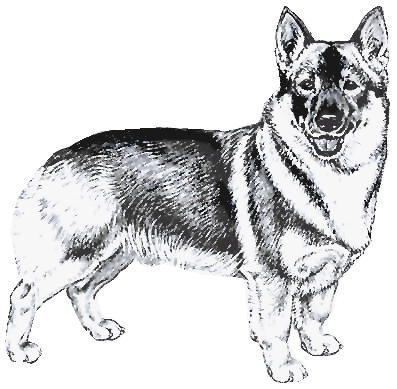FCI-Standard N° 14 / 18. 02. 2000 / GB
SWEDISH VALLHUND
(Västgötaspets)

FCI-Standard N° 14 / 18. 02. 2000 / GB
(Västgötaspets)

ORIGIN : Sweden
DATE OF PUBLICATION OF THE ORIGINAL VALID STANDARD : 25.11.1999
UTILIZATION : Herding Heeler
CLASSIFICATION F.C.I. : Group 5 Spitz and primitive types
Section 3 Nordic Watchdogs and Herders Without working trial
BRIEF HISTORICAL SUMMARY : The Swedish Vallhund is considered to be one of the genuine Swedish breeds even if it is not quite clear how it is related to the Welsh Corgi.
It is hart to say if the Vikings brought dogs of this spitztype to Sweden from England. Modern cynological research points to that the breed was developed in Sweden.
The honor of making the Swedish Vallhund recognized and registered as a Swedish breed goes to Count Björn von Rosen. In the beginning of the 1940s he noticed the existence of these dogs. By making an inventory of the existing dogs in the county of Västergötland and especially around the city of Vara he found a small but evenly typed group of dogs. They were the start of a serious breeding program that was mainly in the hands of the headmaster K.G.Zettersten. He succeded in breeding for an even type without losing the herding insctinct.
GENERAL APPEARANCE : A small powerful, fearless, short-legged dog. Appearance and expression denote a watchful, alert and energetic dog.
IMPORTANT PROPORTIONS : The relation between height and length of body is about 2 : 3.
BEHAVIOUR / TEMPERAMENT : The breed is watchful, energetic, fearless and alert.
HEAD : Head rather long and clean cut. When viewed from above, forms an even wedge from skull to tip of nose.
CRANIAL REGION :
Skull : Almost flat.
Stop : Well defined.
FACIAL REGION :
Nose : Pigmentation jet black.
Muzzle : When viewed from the side, looks rather square. The muzzle is slightly shorter than the skull.
Lips : Tightly closed.
Jaws/Teeth : Perfect and regular scissor bite with even and well developed teeth.
Eyes : Medium size, oval in shape and dark brown.
Ears : Medium size, pointed, pricked and ear leather is hard from base to tip, smooth haired and mobile. Set on not too low.
NECK : Long and strongly muscled with good reach.
BODY :
Topline : Back level, well muscled.
Loin : Short, strong.
Croup : Broad and slightly sloping.
Chest : Long with good depth. Well sprung ribs. When viewed from the front, the chest is oval, from side, elliptical. It reaches two-fifths of the length of the forelegs and, when viewed from the side, the lowest point of the chest is immediately behind the back part of the foreleg.
Underline : Belly slightly tucked up.
TAIL : Two types of tails occur, long or natural short tail. In both cases all variations are acceptable.
LIMBS :
FOREQUARTERS : Forelegs well boned.
Shoulder : Shoulder-blade long and well laid back .
Upper arm : Slightly shorter than the shoulders and set at a distinct angle. Upper arm lies close to ribs, but is still very mobile.
Forearm : When viewed from the front, slightly bent, just enough to give them free action against the lower part of the chest.
Pastern : Elastic.
Legs : Well boned.
HINDQUARTERS : Hindlegs well angulated at stifle and hock. Seen from behind, they are parallel.
Thighs : Strongly muscled.
Lower thigh : Slightly longer than the distance from hock to ground.
FEET : Medium sized, short, oval, pointing straight foreward with strong pads and well knuckled up.
GAIT / MOVEMENT : Sound with good drive.
COAT :
HAIR : Medium length, harsh, close and tight topcoat; undercoat soft and dense. The coat is short on foreparts of the legs, slightly longer on neck, chest and backparts of the hindlegs.
COLOUR : Desirable colours are grey, greyish brown, greyish yellow or reddish brown with darker hairs on back, neck and sides of the body. Lighter hair in the same shade of colour as mentioned above can be seen on muzzle, throat, chest, belly, buttocks, feet and hocks. Lighter markings on shoulders, so called harness markings, desirable.
White is permitted to a small extent as a narrow blaze, neckstop or slight necklace. White markings are permitted on fore-and hindlegs and on the chest.
SIZE AND WEIGHT :
Height at withers : Dogs 33 cm.
Bitches 31 cm.
A variation of 1,5 cm above or below these heights is permitted.
Weight : Between 9 - 14 kg.
FAULTS : Any departure from the foregoing points should be considered a fault and the seriousness with which the fault should be regarded should be in exact proportion to its degree.
Any dog clearly showing physical or behavioural abnormalities shall be disqualified.
N.B. : Male animals should have two apparently normal testicles fully descended into the scrotum.